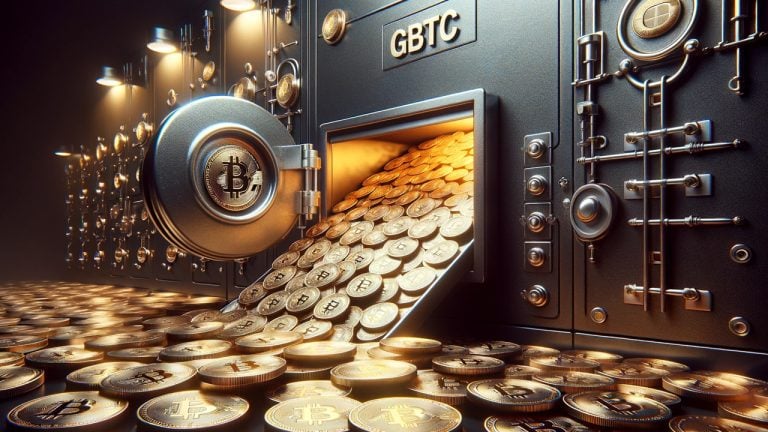
Major Outflows Hit Grayscale's GBTC
Prior to Wednesday's market opening, Grayscale's exchange-traded fund, GBTC, reported holding 605,890.87 bitcoin in reserves. However, according to the company's most recent update, there has been a significant decrease in GBTC's holdings, with a reduction of 13,793.09 bitcoin, valued at approximately $571 million.
Staggering BTC Withdrawals
This recent decline in reserves marks another 13,793.09 BTC withdrawal from Grayscale's assets since Bitcoin.com News covered its reductions on Wednesday. Analyzing data from Jan. 14, 2024, records show that Grayscale's Bitcoin Trust had a total of 617,079 BTC. Consequently, within a span of just four days, a staggering 24,981.22 BTC has been withdrawn from the fund. This substantial outflow, occurring from Jan. 14 to Jan. 17, represents a removal of over $1 billion in value from the fund's bitcoin holdings.
Current GBTC Holdings
Currently, as of 2:38 p.m. Eastern Time (ET) on Thursday, the GBTC holdings stand at roughly 592,097.78 BTC. Calculated at the prevailing exchange rate prices at the same moment in time, the value of the fund's BTC cache is estimated to be around $24.5 billion. GBTC once held an edge on the market when it was traded over-the-counter (OTC) and before it recorded a discount to net asset value (NAV), in 2019 it witnessed a significant premium.
Competition from Other Bitcoin ETFs
When it became a discount in February 2021, the discount to NAV widened a great deal and lasted up until the fund was converted into a publicly accessible spot bitcoin ETF. The market may be feeling the brunt of these sales, but at the same time, several newly approved spot bitcoin ETFs are stacking BTC reserves. Blackrock's IBIT now holds 25,067 BTC and the Fidelity Wise Origin Bitcoin Fund (FBTC) holds 20,507 BTC. Bitwise's BITB, with 8,309 BTC, secures its position as the third-largest (excluding GBTC) among bitcoin ETFs in terms of BTC reserves.
Market Outlook and Analyst Predictions
Ran Neuner, the founder of Crypto Banter, recently shared insights about the GBTC outflows on the social media platform X. "The GBTC overhang will be around for a while. I don't see any way that the other ETF's absorb it," Neuner remarked. "If Blackrock had huge immediate buyers, they would be in already. I suspect and have been warning that we are due for a correction and we may be midway through it. My first downside target is $39,600 to close the CME gap," he added.
JPMorgan market strategists led by Nikolaos Panigirtzoglou detailed in a note sent to investors on Thursday that an additional $1.5 billion might still depart from the bitcoin ETF market through GBTC profit-taking. This scenario could exert "further pressure on bitcoin prices over the coming weeks," Panigirtzoglou wrote. Analysts had earlier projected a decrease of $3 billion in GBTC's value, and to date, approximately half of this anticipated reduction has materialized. By 4:11 p.m. (ET) on Thursday, BTC was trading for $40,838 per unit, after hitting a 24-hour low of $40,600 at 3:00 p.m. during the afternoon trading sessions.
What do you think about the GBTC outflows since the exchange-traded fund started trading publicly last week? Share your thoughts and opinions about this subject in the comments section below.
Frequently Asked Questions
Which is more powerful: sterling silver or 14k gold?
Gold and silver are strong metals, but sterling silver is much less expensive because it contains 92% pure silver rather than just 24%.
Sterling silver is also known by the name “fine silver” because it is made up of a mixture from silver and metals like zinc, copper, and zinc.
Gold is generally considered to be very strong. It takes a lot of pressure to break it down. If you drop something on top of a chunk of gold it will shatter into thousands of pieces rather than breaking into two halves.
Silver isn't nearly as strong as either gold or silver. A sheet of silver would likely bend and fold if you dropped an item on it.
Silver is often used to make jewelry and coins. Therefore, its value tends to fluctuate based on supply and demand.
What are the 3 types IRAs?
There are three basic types of IRAs. There are three types of IRAs: Roth, Traditional, and SEP. Each has its own advantages and disadvantages. Each of these types will be described below.
Traditional Individual Retirement Account (IRA).
A traditional IRA allows you to contribute pre-tax money to an account where you can defer taxes on contributions made now while earning interest. You can withdraw money from the account tax-free after you retire.
Roth IRA
With a Roth IRA, you deposit after-tax dollars into an account, which means any earnings grow tax-free. When you withdraw funds from the account for retirement purposes, withdrawals are also exempted from tax.
SEP IRA
Similar to a Roth IRA except that employees must make additional contributions. These additional contributions are taxed, but any earnings grow tax-deferred once again. When you leave your company, you may convert the entire amount into a Roth IRA.
What kind of IRA can you use to hold precious metals in?
Many financial institutions and employers offer an individual retirement account (IRA) as an investment option. A IRA is a way to make money and allow it to grow tax-deferred, until you withdraw it.
An IRA lets you save taxes and pay them off later. This means more money deposited into your retirement plan today versus having to pay taxes on that money tomorrow.
An IRA is a tax-free way to make contributions and earn income until you withdraw the funds. You can face penalties if you withdraw funds before the deadline.
After 50 you can still make contributions to your IRA. There is no penalty. If you choose to take withdrawals from your IRA during retirement, you'll owe income taxes and a 10% federal penalty.
Withdrawals made before age 59 1/2 are subject to a 5% IRS penalty. Withdrawals between ages 59 1/2 and 70 1/2 are subject to a 3.4% IRS penalty.
There is a 6.2% penalty for withdrawals over $10,000 per calendar year.
Statistics
- If you accidentally make an improper transaction, the IRS will disallow it and count it as a withdrawal so that you would owe income tax on the item's value and, if you are younger than 59 ½, an additional 10% early withdrawal penalty. (forbes.com)
- Depending on your financial situation, most experts recommend you invest no more than 5% to 10% of your retirement funds in precious metals. (forbes.com)
- You can only purchase gold bars of at least 99.5% purity. (forbes.com)
- Same tax rules as traditional IRA SEP IRA contributions in 2022 are limited to 25% of compensation or $66,000, whichever is less Before setting up a Silver IRA, understand the fees and IRS restrictions. (sltrib.com)
External Links
en.wikipedia.org
wsj.com
kitco.com
takemetothesite.com
How To
How to change your IRA to a gold IRA
Do you want to change your retirement savings away from a traditional IRA and into a golden IRA? This article will show you how to do it. Here's how you can do it.
“Rolling over” is the act of transferring money from one type (traditional) to another type (gold). Rolling over an IRA account can provide tax advantages. Some people also prefer to invest in physical assets such as precious metals.
There are two types IRAs – Traditional IRAs (or Roth IRAs). The difference between the two types is that Traditional IRAs let investors deduct taxes from earnings. Roth IRAs don’t allow this. That means that if you invest $5,000 in a Traditional IRA today, then after five years, you'll only be able to take out $4,850. However, if you put the same amount into a Roth IRA you would be able keep every penny.
This is what you need to know if you want to convert an IRA from a conventional to a IRA to a IRA with gold.
First, you will need to decide whether your current balance should be transferred to a new account. You will pay income tax on earnings above $10,000 when you transfer money. If you decide to roll over your IRA you will not be subject to income tax on these earnings until you turn 59 1/2.
Once you've made up your mind, you'll need to open up a new account. It is likely that you will be asked to prove your identity by providing proof such as a Social Security card or passport. After that, you'll need to sign paperwork proving you own an IRA. Once you have completed all the forms, you will submit them to bank. You'll be verified and given instructions on where you can send your wire transfers and checks.
This is the fun part. You'll deposit cash into your new account and wait for the IRS to approve your requests. After approval is granted, you will receive a letter saying that you are now allowed to withdraw funds.
That's it! All you need to do now is watch your money grow. And remember, if you ever change your mind about converting your IRA, you can always close it out and roll over the remaining balance into a new IRA.
—————————————————————————————————————————————————————————————-
Based on [POSTTITLE]
by [POSTAUTHOR]















